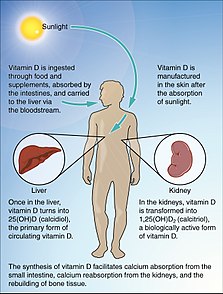ビタミンD欠乏症
この記事は英語版の対応するページを翻訳することにより充実させることができます。(2021年12月) 翻訳前に重要な指示を読むには右にある[表示]をクリックしてください。
|
ビタミンD欠乏症(英: Vitamin D deficiency)は、ビタミンD値が正常値を下回る疾患のことである[3]。
| ビタミンD欠乏症 | |
|---|---|
| 別称 | Hypovitaminosis D |
 | |
| The normal process of Vitamin D absorption | |
| 概要 | |
| 症状 | Usually asymptomatic |
| 原因 | Lack of ビタミンD, inadequate 日光 exposure |
| 危険因子 | Age, people with dark skin, obesity, malabsorption, bariatric surgery, breastfed infants[1] |
| 診断法 | Measuring the concentration of calcifediol in the blood |
| 合併症 | Rickets, osteomalacia, other associated disorders |
| 予防 | Sufficient sunlight exposure, dietary intake |
| 使用する医薬品 | Cholecalciferol, ergocalciferol, calcifediol |
| 治療 | Supplements |
| 頻度 | Deficiency 20-40%, severe deficiency 6-13%[2] |
| 分類および外部参照情報 | |
症状には、筋肉痛、脱力感、筋収縮などがあげられるが、ほとんどの場合が無症状である[4][5]。小児の場合は、骨が適切に石灰化しない病気のくる病を引き起こす[6]。成人の場合は、骨軟化症を引き起こし、骨粗鬆症になる可能性と共に骨折のリスクが高くなる[6][4]。ビタミンDの欠乏は多くの状態と関連してるが、それらが原因であるかどうかは不明である[2]。
ビタミンD欠乏症の原因には、不十分な日光への暴露、食事からの摂取量の減少、腎臓の障害、腸からの吸収の減少などがあげられる[6][4]。その他の危険因子には、肝疾患や特定の遺伝性疾患があげられる[4]。診断は、血中の25(OH)Dレベルに基づき、50〜75nmol/L(20〜30ng/ml)未満の場合にビタミンD欠乏症と診断される[2]。症状のない人を検査することは、利点が不明確であるため、推奨されない[6][7]。
ビタミンDサプリメントの一般的な使用は勧められない[3]。ビタミンD欠乏症の治療は、ビタミンDの経口摂取が一般的である[4]。食事からの摂取源には、脂質の多い魚、きのこ、卵黄などがあげられる[6][8]。国または地域によってはビタミンD強化されたミルクやその他の食品がある[6]。さらに、カルシウムとリン酸塩の欠乏の矯正が必要な場合もある[4]。
ビタミンD欠乏症の罹患者数は人口の約20〜40%であり、その内、重度の欠乏症は6〜13%である[2]。ただし、これらの統計は血液検査に基づくもので、健康への悪影響に関連するものではない[3]。一般的に幼児と高齢者にみられる[2]。ビタミンDの欠乏が主な原因のくる病は、1645年には報告されている [9]。
外部リンク
編集出典
編集- ^ “Office of Dietary Supplements - Vitamin D” (英語). ods.od.nih.gov. 31 October 2020閲覧。
- ^ a b c d e Amrein, K; Scherkl, M; Hoffmann, M; Neuwersch-Sommeregger, S; Köstenberger, M; Tmava Berisha, A; Martucci, G; Pilz, S et al. (20 January 2020). “Vitamin D deficiency 2.0: an update on the current status worldwide.”. European Journal of Clinical Nutrition 74 (11): 1498–1513. doi:10.1038/s41430-020-0558-y. PMC 7091696. PMID 31959942.
- ^ a b c LeFevre, ML; LeFevre, NM (15 February 2018). “Vitamin D Screening and Supplementation in Community-Dwelling Adults: Common Questions and Answers.”. American family physician 97 (4): 254-260. PMID 29671532.
- ^ a b c d e f “Vitamin D Deficiency and Dependency - Nutritional Disorders”. Merck Manuals Professional Edition. 9 April 2021閲覧。
- ^ Sizar, O; Khare, S; Goyal, A; Bansal, P; Givler, A (January 2021). Vitamin D Deficiency. PMID 30335299.
- ^ a b c d e f “Office of Dietary Supplements - Vitamin D” (英語). ods.od.nih.gov. U.S. Department of Health & Human Services: National Institutes of Health (26 March 2021). 9 April 2021時点のオリジナルよりアーカイブ。9 April 2021閲覧。
- ^ Krist, Alex H.; Davidson, Karina W.; Mangione, Carol M.; Cabana, Michael; Caughey, Aaron B.; Davis, Esa M.; Donahue, Katrina E.; Doubeni, Chyke A. et al. (13 April 2021). “Screening for Vitamin D Deficiency in Adults: US Preventive Services Task Force Recommendation Statement”. JAMA 325 (14): 1436. doi:10.1001/jama.2021.3069.
- ^ Bordelon, P; Ghetu, MV; Langan, RC (15 October 2009). “Recognition and management of vitamin D deficiency.”. American family physician 80 (8): 841-6. PMID 19835345.
- ^ Epstein, Sol (2012) (英語). Vitamin D, An Issue of Rheumatic Disease Clinics - E-Book. Elsevier Health Sciences. p. 62. ISBN 978-1-4557-4313-1